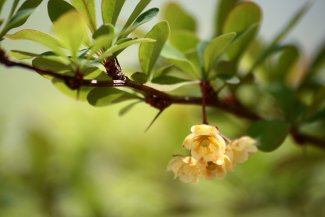Japan and Eastern Asia
It is a dense, deciduous, spiny shrub which grows 2 to 8 ft high. It has deeply grooved, brown, spiny branches with a single (occasionally tridentine) spine (actually a highly modified leaf) at each shoot node. The leaves are green to blue-green (reddish or purple in some horticultural variants), very small, spatula to ovalshaped. The flowers are pale yellow, produced in drooping 1-1.5 cm long umbrella-shaped clusters of 2–5; flowering is from mid spring to early summer. The edible fruit is a glossy bright red to orange-red, ovoid berry 7–10 mm long and 4–7 mm broad, containing a single seed. They mature during late summer and fall and persist through the winter.
Berberis thunbergii is widely grown as an ornamental plant, both in Japan and elsewhere in the temperate Northern Hemisphere. Numerous cultivars have been selected, including plants selected for yellow, dark red to violet, or variegated foliage, erect growth (for hedge use), and dwarf size.
